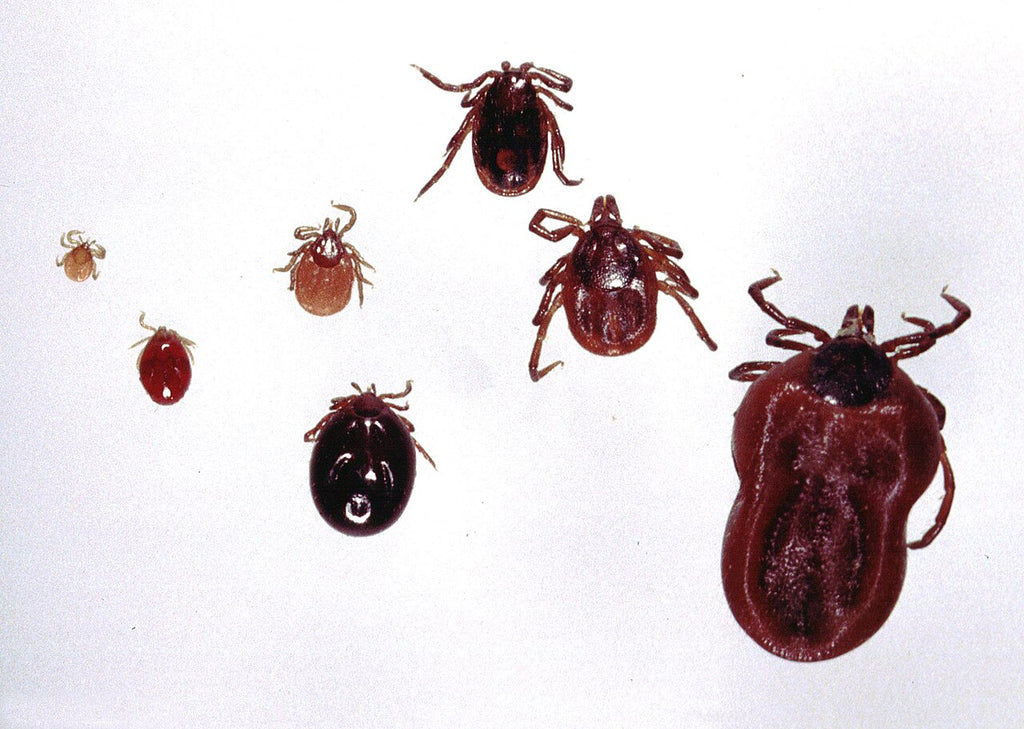
Gardening is in general a fairly safe activity if we take a few precautions by protecting ourselves against the heat, the weather, and if we’re careful with our tools. And while all gardeners know that there are some insects and other pests that can be annoying, generally they’re not dangerous unless we have allergies or other health issues. There’s one garden pest however that can have a lasting impact on our health by spreading an infection—ticks and tick bites can spread Lyme disease, which while seldom fatal can have a lifelong effect on health and wellness. Let’s dig in and learn a bit more about Lyme Disease, what it is and what it does, and how we can protect ourselves from it.
As always, please remember that we’re gardeners, not medical experts, and nothing we say here should be taken as medical advice. If you have a medical issue or health concern, please seek professional attention immediately.
What is Lyme Disease?
Lyme Disease is well-known as a tick-borne illness, but the ticks themselves don’t cause the infection. Rather, bacteria from the species Borrelia live inside the ticks and are transferred to humans and other animals via tick bites. Not all ticks carry Lyme disease, either—it’s mostly found in those from the genus Ixodes.
While Lyme disease was gradually identified by scientists and medical researchers over a few decades in the late 19th and early 20th centuries, the symptoms have been well-known for centuries. Found throughout the Northern Hemisphere, Lyme disease develops gradually. After an incubation period of anywhere between a few days and several months, symptoms usually start to appear. The first sign or symptom of a Lyme disease infection is nearly always a rash called Erythema migrans. This rash appears anywhere between a few days and a month after the tick passes the disease to the human, and begins at the site of the bite. As the migrans part of the name suggests, it does spread or “migrate” growing outward gradually and reaching a size of 12 inches/30cm or more. Strangely, Erythema migrans is generally not painful to the touch, although it may feel warm or flushed.
Later on, other symptoms occur. While a given patient may not experience all of them, here are some of the most common signs of an ongoing Lyme infection:
- Fever
- Headache
- Stiff neck, or joint and body pain
- Difficulty concentrating
- Fatigue, especially during or after physical activity
- Swellingaround lymph nodes or joints
- Areas of numbness, tingling, or other abnormal sensations
If left untreated, Lyme disease can cause lasting problems like heart issues, neuropathy, or facial paralysis. If you suspect Lyme disease exposure or infection, please seek medical attention as soon as possible. Lyme disease is generally treated with antibiotics, and treatments are more effective if begun promptly.

Avoiding Ticks and Preventing Lyme Disease
The best way to prevent Lyme disease is to avoid contact with ticks, and the best way to avoid contact with ticks is to prevent them from taking up residence in your garden. While Lyme is more common in some parts of the world than others and you need to know your local conditions, here are some basics for keeping your outside spaces as tick-free as possible:
- Ticks prefer grassy, overgrown, or wooded areas, so keep your outside spaces and garden free of debris and overgrown grass to prevent tick infestations. We do encourage you to keep some parts of your lawn “wild” to support local wildlife if possible, but the spaces humans use should be kept reasonably well tended.
- In your garden, grow some plants that help repel ticks and other pestsin order to keep your space free and clear of annoying, biting insects like ticks, mosquitoes, and biting flies. Many of them are wonderful plants to have in your garden anyway, so it’s a win-win situation.
- Wear long sleeves, high boots, and treat yourself and your clothing with tick-repelling bug spray before and during outdoor activities. Prevention is better than cure, and by keeping ticks away from you and your skin you’ll help avoid Lyme disease.
- Check yourself, your pets, and your children for ticks after time outsideand make sure to promptly remove any ticks you find. The CDC has a great guide for how to do those things, so please read the full article for detailed information; it’s a bit too much for us to share in full.
- We need to say it one more time: contact a medical professional if you suspect you’ve been exposed to Lyme disease! Prompt medical attention helps so much, so err on the side of caution.

We know this isn’t the happiest subject we’ve ever covered in this blog. Lyme disease isn’t something to be afraid of, but rather something to be aware of. By knowing the facts of Lyme disease, how to spot the signs and symptoms, and how to prevent it, we’ll all be safer and healthier both in our gardens and during other outdoor activities. Gardzen is all about community and we want what’s best for all of you, so please take care of yourselves!

I’m really grateful you posted this article! This is an awesome public service announcement to our fellow gardeners to be cautious. No one wants their growing season time to be compromised by not feeling well. Lymes can become very serious thanks for putting this out here to remind us to exercise caution.
I definitely don’t love reading about these things, but it’s helpful to know so thank you! Also good to know that there are plants that actually help deter pests.
Leave a comment